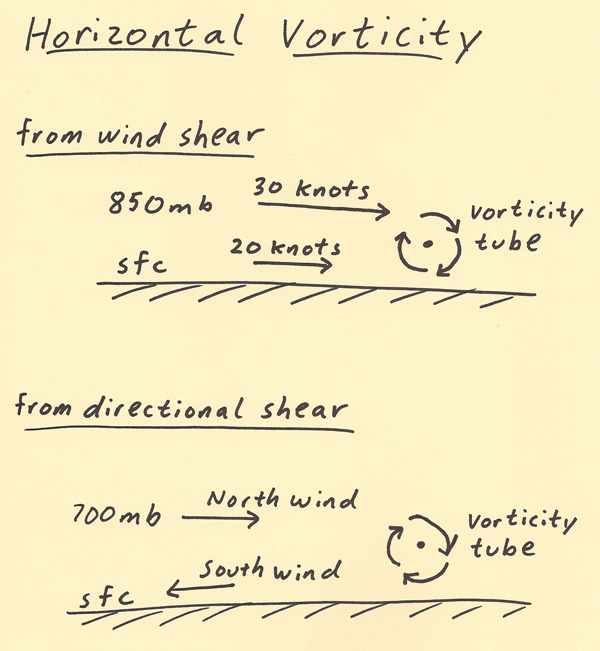
Vorticity is a turning of airflow. Horizontal vorticity is vorticity that spins about an axis parallel to the Earth’s surface. Vertical vorticity is vorticity that spins about an axis perpendicular to the Earth’s surface such as 500-mb vorticity analyzed on the 500-mb prog. This writing will focus on horizontal vorticity that is generated in the lower troposphere closer to the ground such as between the surface and 700 mb. The generation of vorticity can be thought of as a pinwheel. The pinwheel can be set in motion by airflows striking it from different directions or when different wind speeds strike different regions. The diagram below shows how tubes of vorticity can be generated from speed shear and directional shear. In the situation of wind shear, the wind speed changes significantly with height. Typically this will include a wind speed increase with height since the winds higher up are less influenced by the slowing force of surface friction. The frictional force is higher at higher wind speeds thus in many situations the wind speed will increase more rapidly with height when the overall wind speed is higher (such as in the warm sector of a mid-latitude cyclone). Horizontal vorticity can also be initiated by a directional change in the wind with height. The wind flowing from different angles can set a tube of vorticity into motion. Friction also contributes to the wind turning with height and this height wind direction change can be enhanced by stronger wind (such as in the warm sector of a mid-latitude cyclone). The diagram below shows an example of a tube of vorticity being generated by speed shear and a tube of vorticity being generated by directional shear. In the speed shear situation, the winds higher up are stronger than the wind near the surface. This imbalance of wind flow initiates a spinning tube of vorticity. In the directional shear situation, the winds are striking the tube from different directions helping to keep it spinning. Both speed and directional wind shear work together to create a spinning tube of vorticity. This is very important for severe thunderstorm situations since a thunderstorm updraft can ingest the horizontal vorticity which can produce a rotating updraft which can lead to tornadogenesis in the right circumstances.  |